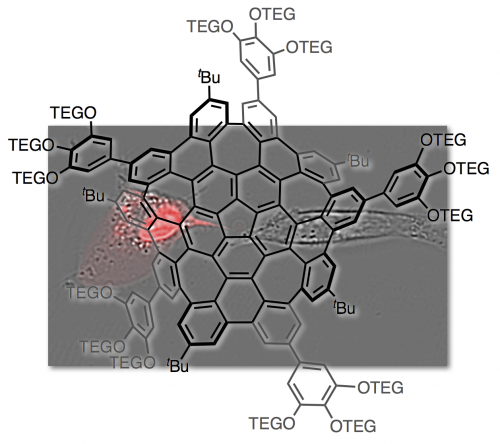


Hsing-An Lin, Yoshikatsu Sato,* Yasutomo Segawa,* Taishi Nishihara, Nagisa Sugimoto, Lawrence T. Scott, Tetsuya Higashiyama, and Kenichiro Itami*
Angew. Chem. Int. Ed. 2018, DOI: 10.1002/anie.201713387
 Nanographene, a small piece of graphene, has attracted unprecedented interest across diverse scientific disciplines particularly in organic electronics. The biological applications of nanographenes, such as bioimaging, cancer therapies and drug delivery, provide significant opportunities for breakthroughs in the field. However, the intrinsic aggregation behavior and low solubility of nanographenes, which stem from their flat structures, hamper their development for bioapplications. Herein, we report a water- soluble warped nanographene (WNG) that can be easily synthesized by sequential regioselective C–H borylation and cross-coupling reactions of the saddle-shaped WNG core structure. The saddle- shaped structure and hydrophilic tetraethylene glycol chains impart high water solubility to the WNG. The water-soluble WNG possesses a range of promising properties including good photostability and low cytotoxicity. Moreover, the water-soluble WNG was successfully internalized into HeLa cells and promoted photo-induced cell death.
Nanographene, a small piece of graphene, has attracted unprecedented interest across diverse scientific disciplines particularly in organic electronics. The biological applications of nanographenes, such as bioimaging, cancer therapies and drug delivery, provide significant opportunities for breakthroughs in the field. However, the intrinsic aggregation behavior and low solubility of nanographenes, which stem from their flat structures, hamper their development for bioapplications. Herein, we report a water- soluble warped nanographene (WNG) that can be easily synthesized by sequential regioselective C–H borylation and cross-coupling reactions of the saddle-shaped WNG core structure. The saddle- shaped structure and hydrophilic tetraethylene glycol chains impart high water solubility to the WNG. The water-soluble WNG possesses a range of promising properties including good photostability and low cytotoxicity. Moreover, the water-soluble WNG was successfully internalized into HeLa cells and promoted photo-induced cell death.